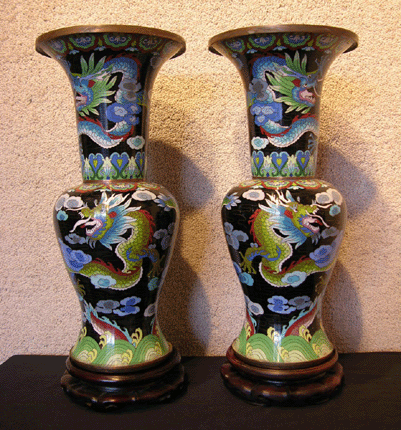
Attribute to early 20th C. Came out of China in mid 1990s. Lively portrayal of writhing dragons. 18″h, 8.5″ w
The vases are of the long-neck, flared mouth type. A thin copper band at the base of the neck separates the neck from the body. The flared mouth is decorated on the outside with a frieze of ruyi lappets (symbol of a wish for long life and good fortune). This frieze is repeated around the shoulder of the body. At the base of the neck and on the wide swath inside the mouth, a band of stylized lotus petals is depicted.
A fierce-looking five-clawed dragon decorates the neck of the vase. This motif is repeated, with two dragons, on the bulbous body. With scaled bodies of a serpent, white horns, fluttering manes, circular bulging eyes and sharp teeth in gaping jaws, they exhibit a fierceness associated with celebrated dragons of early time. These fabulous creatures, chasing a flaming pearl and rampaging among stylized clouds, symbolize the spirit of divine essence of the gods and are the epitome of concentrated energy and dynamism. A frieze of stylized waves at the foot of the vase completes the overall theme of dragons cavorting in waves. Folklore has it that in the spring, the dragons rise from the waves to ascend to the clouds in the sky; in autumn they retire to the seabed.
Like most early enamels, tiny pits on the surface of the vase can be seen. This is caused by gas escaping out of the metal when it was heated in the furnace. Uneven patches of bubbles on the counter-enameling (to strengthen the thin metal body) inside the vase are also caused by released gas. This is all due to imperfect technique of heating in early stage of enameling. Very few enamelware of the early period escaped this imperfection.